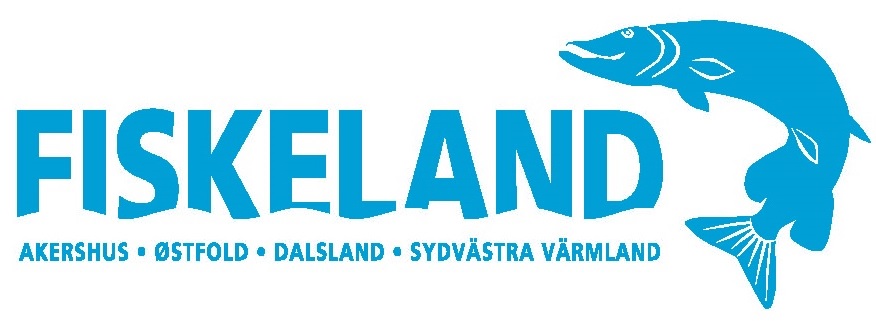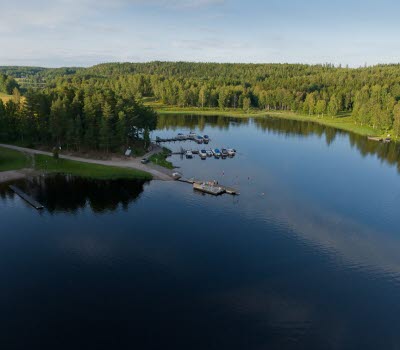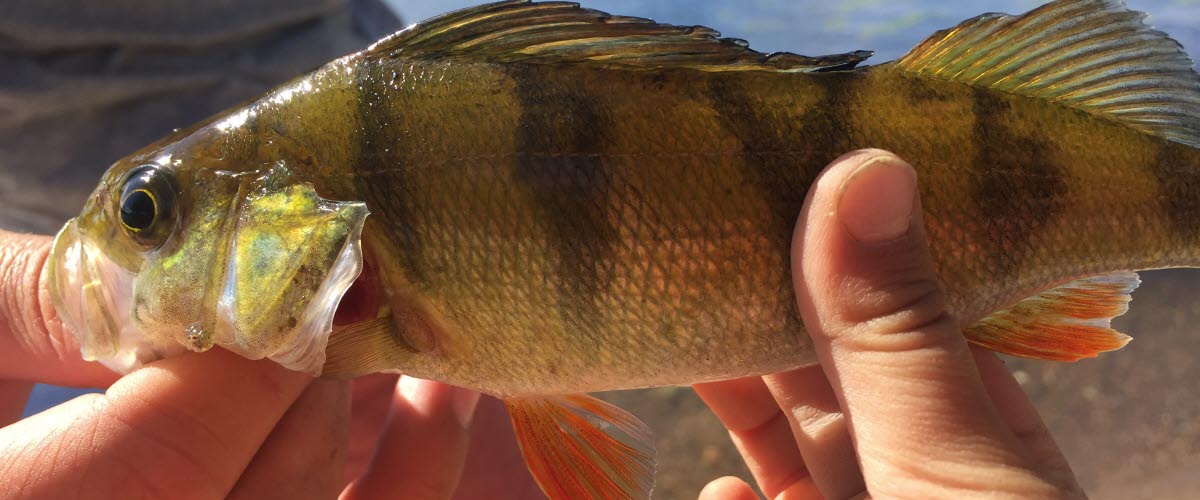Species
You’ll find almost all existing fresh-water fishes in Fiskeland!
If you want to spin-fish for pike or set up the boat for some trolling? Or maybe it’s vertical fishing that you are interested in? Whatever is yours, you can find it in the Fiskeland area, whether you’re a specialist or just want a relaxing fishing weekend with the family.
Most of the fishes you will find in our area are listed in this menu, both the classical sweet-water species and some a bit more unusual.
Bream is one of the largest carp fishes, often weighing in at around 1 kg and over. It’s an fun to hook one, though it sometimes is a random catch using a spin rod. Coarse fishing for bream using small earthworms or dough is both fun and exciting fishing experience. The Fiskeland area offers many virgin waters with large bream, especially popular with English fishermen. Bream can reach 5 kg and 3 kg individuals are rather common, provided you manage to specialize and can find a good fishing site.
A seemingly "forgotten sport fish", the burbot can be caught via ice-fishing or bottom fishing. In the Fiskeland area it is fairly numerous, especially in the larger lakes. The average weight is around 1 kg, but focussed fishing can find individuals at around 3 kg. Burbot has been called fresh-water cod since it is reminiscent of that fish. It is an exciting sport fish, especially for ice-fishing. The best time of day is at twilight and some hours into the evening, as this is when burbot are most active.
Char is represented by a few, smaller stocks in some lakes and in all is rather large. Many sports fishermen consider the char the premium of all fresh-water fishes when it comes to food and sport. The best opportunity for catching char on a rod are in spring, autumn and under the ice. Lakes Västra and Östra Silen, Lilla Le and Lelång are home to different types of great char. In the summer char move to deeper waters are therefore harder to hook. The normal weight is around 1-3 kg.
Grayling
A salmon fish living in running waters, grayling is found in the Glomma River. While usually weighing less than a kilogram, larger individuals have been caught in the Fiskeland area. Fly-fishing is the best method for grayling using worms, small spoons or spinners. It offers a strong fight on lighter equipment and is a very popular sport fish.
Perch is our most common sport fish, a real rod fighter who bites on coarse fishing, spin and ice-fishing. The weight is normally around 2-3 hg, but in the Fiskeland lakes can attain weights around 1-2 kg. Perch can be fished almost all year provided the method is adapted to the season. You’ll find perch in waters ranging from small, dark forest tarns to larger, deep lakes.
Our largest sweet-water fish of prey, pike is omnivorous, voracious and an exciting fish on a rod. While they usually weigh in at 2-3 kg, each year someone catches pike up to 13-15 kg in our waters! Like perch, pike is found in nearly all lakes and running waters. In recent years there’s been an increased interest in fishing for pike.
Also known as zander, pikeperch prefers shallow, eutrophic, somewhat muddy lakes with lots of white fish. It is a popular game and food fish. There are several ways to catch pikeperch on a rod. It has been said that “pikeperch is a mix between pike and perch.” There is some truth to this as the fish has the sharp teeth and long body of a pike, as well as the striped back and dorsal fins of a perch. Pikeperch can weigh in at several kilograms, with 2-3 rather common. In recent years fishing for pikeperch has increased noticeably as vertical fishing has grown in popularity. Today the fish equipment industry offers specially adapted equipment, boats and the like just for vertical jigging.
Rainbow trout, or just ‘rainbow’ as it often is called, is stocked in several smaller waters in the Fiskeland area. One-kilo fish are the most common and the rainbow is a spirited, popular game fish. Thanks to the rainbow trout active sport fishing has grown, especially then fly-fishermen who have had the rainbow as a start fish and source of inspiration. As the rainbow trout is even active in cold water, it can be fished year round. Some of these waters are closed during the cold season so it is important to check before you fish.
Salmon
The land-locked Gullspång and Klarälv salmon are found in 5-6 large lakes in the area, including Lake Vänern. Fast growers, they attain weights of 4-5 kg only a few years of being released. The vendace, available in large amounts, is one of the salmon’s favourite foods. As a game fish, salmon are often hooked using trolling, spin or fly-fishing. Individuals weighing up to 11-12 kg have been caught in Fiskeland. It is also a highly popular food fish with pink, tasty meat.
One fish found in many Fiskeland waters is the tench, a carp fish also called doctor fish. The fish is rather unknown, being averse to both light and company. It prefers eutrophic, shallow lakes with lots of vegetation. It is a popular game fish primarily in England doing coarse fishing. The tench is a recognized fighter when hooked on a rod. The weight is most often half a kilogram, but can reach two. It has a thick, slimy skin.
Trout can be found in both the larger lakes and in smaller brooks and rivers. In the lakes it is usually larger, weighing in at between 2-4 kg. Many sports fishermen consider the trout ‘the big game fish’, superb both on the hook and on the table. The largest trout hooked on a rod in this area weigh in at 11 kg (Lake Vänern). A smaller version called brook trout can be found in smaller waters where it lives its whole life. In some brooks of the Fiskeland area trout is completely protected and may not be caught.
Other species:
European chub
Very similar to the roach, the chub is yet another whitefish that prefers eutrophic waters. It can be hooked using coarse fishing methods, as well as via fly-fishing. However, it’s not very common in the Fiskeland area.
Ide
A voracious hunter, the ide is a whitefish. It’s also an exciting sports fish on both spin and coarse fishing. The ide, also called orfe, eats small animals, insects and small fish. It can reach 2-3 kg, but with luck your hook will lure a larger individual. Unfortunately it’s not common in the Fiskeland area.
Roach
For many this is often the primary fish on the rod and it’s very common in our lake systems. Measuring 8-15 cm, the roach is somewhat stronger than the bleak and its red eyes are easy to recognize. Though not a major food fish, it’s fun to fish using earthworm, dough or corn. The roach can be found at the edges of cove reeds, brook mouths, canals and other reed fields – indeed in almost all shallow waters.
Rudd
Found in more eutrophic waters and though larger, the rudd looks like the somewhat stronger roach. Rudd weighs in between 3-4 hg and is an exciting rod fish. It eats roe and is quick on the uptake when other fish, like pike, lavaret and bream, are spawning in the shallows. The proper biotopes for rudd are richly vegetated shallows and rather eutrophic waters. Their habitats include brook mouths and other similar flows.
Silverbream
The silver bream is another whitefish. Though its body form similar to the common bream, its markings are often shinier and lighter. It is also smaller than its relative.
Common Bleak
The bleak is common in most lakes and waterways in the Fiskeland area. A very important change in the diet for all fish of prey, it can be found nearly all the lakes and waterways in our area. The bleak can live in immense schools and are an important and happy signal for sports fishermen – the bleak attracts large perch, pike and pikeperch. Using dough or worm/maggot are excellent ways to catch bleak.
Crucian carp
The Crucian carp is a tough, tenacious carp fish with a greater range than normally thought. This carp is rather small and frequently lives in small runs and shallow, highly vegetated lakes. These waters are often so small you don’t expect any fish at all. Coarse fishing catches this carp.
Ruffe
The ruffe is rather common in most of the larger lakes in Fiskeland and is frequently an extra catch during autumn netting for vendace and lavaret. It’s a thorny, slimy fish that creates problems for net fishermen. The ruffe is almost worthless, both as a game fish and for food. It is, however, on the perch menu.
Smelt
As the ruffe, smelt is found in most of the larger lakes in Fiskeland and is another extra catch when netting for vendace and lavaret. In our area the ruffe is rather unusual, though in other places smelt is happily netted and eaten. The smell of fresh cucumber is a typical and immediately recognized sign of smelt in the catch. Normally smelt is an important prey of perch, pike, salmon and trout, all fish that hunt in the open areas of the larger lakes. The term ‘norsabborre’ – smelt perch – in referring to well grown, large individuals that have specialized in eating smelt.
Lavaret
Lavaret is found in the larger, deeper lakes in Fiskeland. A salmonoid fish with a normal weight of 3-4 hg, its weight varies somewhat from lake to lake and depending on the species. Individuals weighing as much as 3-4 kg have been caught, but are exceptions. The laveret species in our area seldom bite on a rod and are mostly appreciated as a good food fish. Large numbers can be seen when the lavaret spawn during the late autumn in shallow waters. It is also an important prey for other hunting fish – large pike are often lured into shallow waters during the autumn spawning period.
Vendace
As the lavaret, the vendace is found in most of Fiskeland’s larger, deeper lakes. A smaller salmonoid fish that can be confused with small bleak, the vendace is only fished using nets. Vendace has also been fished in the autumn using seines. It spawns in October-November and is one of the most important prey fishes in the Fiskeland area.







